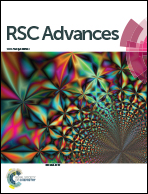Anticancer activity of 4-aminoquinoline-triazine based molecular hybrids†
Abstract
In this study the potential for anticancer activity of 4-aminoquinoline-triazine based hybrids has been investigated on 60 human cancer cell lines (NCI 60). The representative compounds show activity on a range of cell lines and apoptosis as the mode of growth inhibition.


 Please wait while we load your content...
Please wait while we load your content...